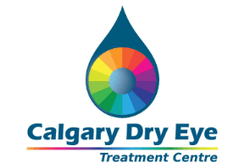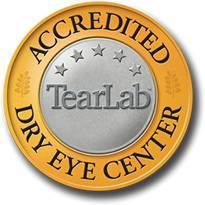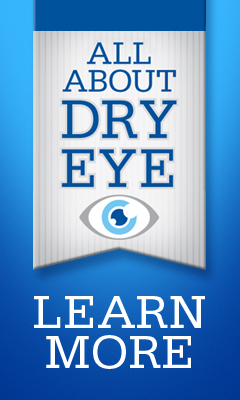One of the problems with Dry Eye is that everybody calls it Dry Eye when dryness may or may not actually be the problem. Non Wetting Eye is closer to the mark, but that's too technical for most eye doctors, let alone patients. So we all use the term Dry Eye as a kind of catch-all to describe anything and everything that could possibly go wrong with your tears. There are actually quite a few things that could go wrong with your tears.
Usually, if you want to solve a problem, it helps to know which problem you have. So, let's try and get a rudimentary understanding of the possible problems.
Problem #1 - Aqueous Deficiency (not making enough of the watery part of your tears)
Truly dry: Now we're talking dryness. This really is "dry eye", if you agree with our logic that absence of moisture = dryness and vice versa. Your lacrimal glands (the things in your upper eyelids) are seriously misbehaving themselves. They just aren't pulling their weight at all - they are underproducing aqueous tears. This is a problem.
How do I know I have it? Good question. There is a test called Schirmers which you may have had, which is supposed to measure aqueous tear production. (If you aren't sure, this is where they stick a pre-measured strip of paper in your lower eye and wait to see how much tears it soaks up in 5 minutes.) You may or may not know by now that it is controversial. To anaesthetise or not to anaesthetise? How should the test be performed? Is it reliable? It figures, you moan. The one standardised test that could actually tell me whether I've got the all-important problem, and doctors are too busy sitting around debating the technicalities of whether and how it works to bother finding a way to ensure it WILL work. - We of course are of the opinion that you should be anaesthetised and left for about 5 minutes for the anaesthetic to take effect. Then we think they should blot the excess anaesthetic drop otherwise the first 10mm of the strip are going to soak up the drops, not your tears. But anyway, however the test is done, if you score less than 10 you're almost certainly not producing enough aqueous tears. If you're a lot less than 10, you're in real trouble. If you're 0, you probably couldn't read this far down on the page - or if so you have a high pain threshold. If you're 30, they probably did the test wrong. If you're anywhere between 10 and 30 they might have done it wrong and you might actually be less than 10 but you won't know. Bottom line, the test might be wrong when it tells you you don't have dry eye, but it's not going to be wrong when it tells you you do have dry eye.
So why aren't your lacrimal glands behaving? You could be taking medications that affect your tear production. If you have ever looked at the side effects lists on medications... well, an awful lot of them mention dry eye as a side effect. Or, you could have a disease that damages the lacrimal glands - auto-immune diseases are good at that. Or, you could have a hormone deficiency. We women are so lucky. You could be getting old. Or, you could have lost some of the sensitivity in your corneas by not blinking enough, wearing contact lenses too much, staring at the computer too much, or having LASIK. For further discussion of the causes, click here.
So what do you DO about aqueous tear deficiency? Traditionally, the standard methods have been to supplement your tears by using fake ones from the pharmacy, and trap your existing tears by plugging the drains that they escape through (using punctal plugs or cautery). These days assessing and treating "the inflammatory component" is increasingly vogue. Restasis is commonly prescribed, and there are more dry eye drugs in development. For severe cases, an excellent treatment is scleral lenses, which act as a constant liquid bandage over the cornea.
Problem #2: Lipid Deficiency: They're evaporating too fast
Okay, so maybe I'm making plenty of tears, but they're disappearing as fast as I can make them. I can't keep up. On the other hand maybe I'm not making enough tears, and even the few I am making are disappearing as I speak. Help!
How do I know this is happening? Probably from a Tear Break-Up Time test. It's a stupid name for it (since what they really mean is evaporating) but basically, they put a little dye on your eye and look at you through the slit-lamp and start counting. The dye is attracted to dry spots, and when dry spots start appearing, that's called tears breaking up (evaporating). As soon as that starts happening they stop counting. If they made it to 10-15 seconds or so, it's working something like normal. If they didn't, it's not normal. If like most of us you're down around 1 second or less, well, you're in real trouble, as if you didn't already know. The other way you will figure it out is just empirically: If you've done everything you can to make sure you have enough tears, and if the doctors swear you aren't dry, but you're still dry, chances are it's because the tears are evaporating faster than you can make or supplement them and trapping them with plugs doesn't help because it only prevents them from draining out through the puncti, not evaporating.
So why are they evaporating too fast? First, remember when we were talking about the lipid layer of your tears? That's what keeps your tears from "breaking up", i.e. evaporating, i.e. floating off into the air. So, if your tears are evaporating too fast you don't have enough oily stuff. This is made by your meibomian glands. They may be making it but it's stiffening up and getting stuck and not being secreted properly onto your eyes. That's called meibomian gland dysfunction (MGD) and is particularly common if you've got blepharitis. Second, if you've got any tendency towards too much evaporation, or you haven't got very many tears in the first place, environmental facts will contribute to the evaporation. Heat and air conditioning dry the air and suck moisture from your eyes. Dry climates and wind make it worse. Third, if your eyes are just getting over-exposed to the air, this will also result in too much evaporation. Strangely enough, it seems many of us sleep with our eyes slightly open without realizing it so surface evaporation may be even more of a problem.
So how do I keep them from evaporating? First and foremost is making more of the stuff that keeps them from evaporating - the oily stuff (lipids) that the meibomian glands produce and keeping your lids nice and clean so the glands don't keep getting clogged up. Lid therapy (hot compresses, lid scrubs and lid massage - don't do these without reading the instructions) does all of those things. Some medications like doxycycline are really helpful for this, and so can some nutritional supplements. Second, you can make a nice friendly environment that at least doesn't increase evaporation: Keep your house humid, which means not overdoing it with the heat. Same with your car - don't overdo air conditioning in summer, do wear wraparound eyewear. Third, since nights can be the worst, be sure to protect your eyes at night.
Problem #3: Mucin Deficiency: They're not sloshing around and sticking on your eyes the way they should.
Remember when we were talking about the sticky part of your tears - the mucin layer, which is between the watery part of your tears and your eye surfaces themselves - the part that actually makes your eyes wet? If you are mucin deficient, for some reason you either don't have enough or what you have isn't doing its job properly. There are tests of some kind for this but they don't seem to be very common and your eye doctor may cross his eyes when you start talking about the assays you looked up on Medline. So most people figure this out empirically: if they are maximally treating aqueous and lipid deficiency and they still have the same symptoms, one explanation is mucin deficiency.
There is no "fix" for mucin problems but this is an area of a lot of current research. Keep an eye out for anything that talks about goblet cell density, since it is directly related. Read about Conditions Related to Dry Eye.



